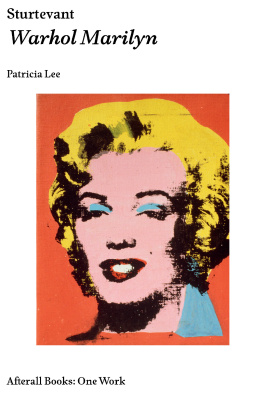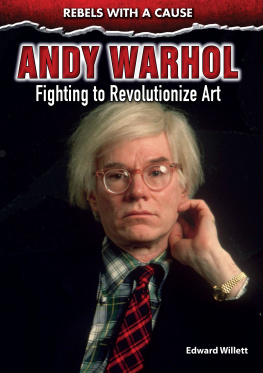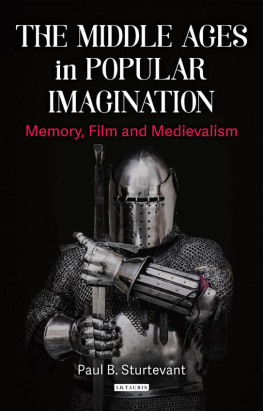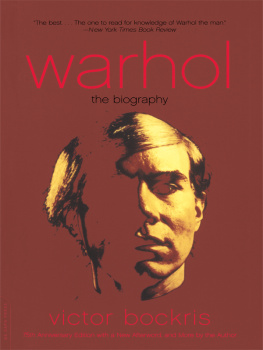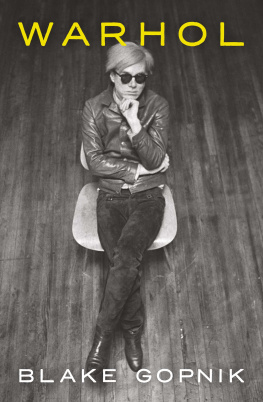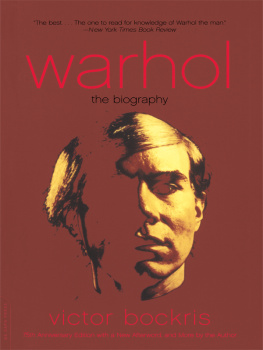Lee Patricia - Sturtevant: Warhol Marilyn
Here you can read online Lee Patricia - Sturtevant: Warhol Marilyn full text of the book (entire story) in english for free. Download pdf and epub, get meaning, cover and reviews about this ebook. City: London [England, year: 2016, publisher: The MIT Press;Afterall Books, genre: Art. Description of the work, (preface) as well as reviews are available. Best literature library LitArk.com created for fans of good reading and offers a wide selection of genres:
Romance novel
Science fiction
Adventure
Detective
Science
History
Home and family
Prose
Art
Politics
Computer
Non-fiction
Religion
Business
Children
Humor
Choose a favorite category and find really read worthwhile books. Enjoy immersion in the world of imagination, feel the emotions of the characters or learn something new for yourself, make an fascinating discovery.
- Book:Sturtevant: Warhol Marilyn
- Author:
- Publisher:The MIT Press;Afterall Books
- Genre:
- Year:2016
- City:London [England
- Rating:5 / 5
- Favourites:Add to favourites
- Your mark:
- 100
- 1
- 2
- 3
- 4
- 5
Sturtevant: Warhol Marilyn: summary, description and annotation
We offer to read an annotation, description, summary or preface (depends on what the author of the book "Sturtevant: Warhol Marilyn" wrote himself). If you haven't found the necessary information about the book — write in the comments, we will try to find it.
Sturtevant: Warhol Marilyn — read online for free the complete book (whole text) full work
Below is the text of the book, divided by pages. System saving the place of the last page read, allows you to conveniently read the book "Sturtevant: Warhol Marilyn" online for free, without having to search again every time where you left off. Put a bookmark, and you can go to the page where you finished reading at any time.
Font size:
Interval:
Bookmark:
One Work is a unique series of books published by Afterall, a Research Centre of University of the Arts London, located at Central Saint Martins. Each book presents a single work of art considered in detail by a single author. The focus of the series is on contemporary art and its aim is to provoke debate about significant moments in arts recent development.
Over the course of more than one hundred books, important works will be presented in a meticulous and generous manner by writers who believe passionately in the originality and significance of the works about which they have chosen to write. Each book contains a comprehensive and detailed formal description of the work, followed by a critical mapping of the aesthetic and cultural context in which it was made and that it has gone on to shape. The changing presentation and reception of the work throughout its existence is also discussed, and each writer stakes a claim on the influence their work has on the making and understanding of other works of art.
The books insist that a single contemporary work of art (in all of its different manifestations), through a unique and radical aesthetic articulation or invention, can affect our understanding of art in general. More than that, these books suggest that a single work of art can literally transform, however modestly, the way we look at and understand the world. In this sense the One Work series, while by no means exhaustive, will eventually become a veritable library of works of art that have made a difference.
One Work Series Editor
Mark Lewis
Afterall Books Editorial Directors
Charles Esche and Mark Lewis
Editor
Caroline Woodley
Associate Editor
Line Ellegaard
Copy Editor
Deirdre ODwyer
Research Assistant
Ambra Gattiglia
:
Bas Jan Ader: In Search of the Miraculous
by Jan Verwoert
Hollis Frampton: (nostalgia)
by Rachel Moore
Ilya Kabakov: The Man Who Flew into Space from his Apartment
by Boris Groys
Richard Prince: Untitled (couple)
by Michael Newman
Joan Jonas: I Want to Live in the Country (And Other Romances)
by Susan Morgan
Mary Heilmann: Save the Last Dance for Me
by Terry R. Myers
Marc Camille Chaimowicz: Celebration? Realife
by Tom Holert
Yvonne Rainer: The Mind is a Muscle
by Catherine Wood
Fischli and Weiss: The Way Things Go
by Jeremy Millar
Andy Warhol: Blow Job
by Peter Gidal
Alighiero e Boetti: Mappa
by Luca Cerizza
Chris Marker: La Jete
by Janet Harbord
Hanne Darboven: Cultural History 18801983
by Dan Adler
Michael Snow: Wavelength
by Elizabeth Legge
Sarah Lucas: Au Naturel
by Amna Malik
Richard Long: A Line Made by Walking
by Dieter Roelstraete
Marcel Duchamp: tant donns
by Julian Jason Haladyn
General Idea: Imagevirus
by Gregg Bordowitz
Dara Birnbaum: Technology/Transformation: Wonder Woman
by T.J. Demos
Gordon Matta-Clark: Conical Intersect
by Bruce Jenkins
Jeff Wall: Picture for Women
by David Campany
Jeff Koons: One Ball Total Equilibrium Tank
by Michael Archer
Richard Hamilton: Swingeing London 67 (f)
by Andrew Wilson
Martha Rosler: The Bowery in two inadequate descriptive systems
by Steve Edwards
Dan Graham: Rock My Religion
by Kodwo Eshun
Yayoi Kusama: Infinity Mirror Room Phallis Field
by Jo Applin
Michael Asher: Kunsthalle Bern, 1992
by Anne Rorimer
Hlio Oiticica and Neville DAlmeida: Block-Experiments in Cosmococa program in progress
by Sabeth Buchmann and Max Jorge Hinderer Cruz
Sanja Ivekovi: Triangle
by Ruth Noack
Rodney Graham: Phonokinetoscope
by Shepherd Steiner
Lee Lozano: Dropout Piece
by Sarah Lehrer-Graiwer
Philip Guston: The Studio
by Craig Burnett
Thomas Hirschhorn: Deleuze Monument
by Anna Dezeuze
Mike Kelley: Educational Complex
by John Miller
Lee Friedlander: The Little Screens
by Saul Anton
In Warhol Marilyn (1965, ), the face of Marilyn Monroe, one of the most famous Hollywood actresses of the twentieth century, is depicted in what might equally be one of the most well-known portraits in the history of modern art. The silkscreen-and-acrylic painting was composed from a publicity photograph used for the 1953 film Niagara. Bold, colourful strokes of paint float against a background of arresting red, with the photographic image applied in black, wiped with a squeegee through a silkscreen stencil. Monroes hair is denoted by a wide swathe of lemon yellow, her face a porcine pink. Three sky-blue shapes suffice to indicate cosmetic eyeshadow and a halter-neck strap. The red of the background is also put to use as an imprecise dash of lipstick. Striking a balance between the mechanical properties of the appropriated photographic image and its gestural painted elements, Sturtevants Warhol Marilyn presents an image as famous as the silver screen icon it depicts; an image that is a heavily coded icon of Pop art, and more specifically of Andy Warhol.
Warhol took up the portrait soon after Monroe was found dead, on 5 August 1962, from an overdose of pills. He would gain notoriety in the early 1960s for his serial images of celebrities such as Monroe, Elizabeth Taylor and Jackie Kennedy, as well as for his depictions of consumer products, from Campbells Soup Cans (1962) to Brillo Boxes (1964), which drew upon a reservoir of popular culture, advertising and media imagery and exposed the reification of identity endemic in post-War American society. Warhol incorporated elements of chance and speed of execution into his screen-printing method: a work was produced in stages, with the figurative elements put down before the painted ground, and occasionally finished with over-painting by hand.
One might mistakenly identify Warhol Marilyn as one of the silkscreen portraits produced by Warhol more than fifty times between August 1962 and September 1964.
Warhols comment presages the encounter with the picture here in question. Warhol Marilyn, from 1965, and pictured on the cover of this book, is not a Warhol but a Sturtevant. It is accompanied by other screen-printed paintings (
In my own experience of works of works by Sturtevant, I have been impressed by their presence. Not only do they resemble the works from which they were made, they also project a sense of the time from which they hail. Stella Arbeit Macht Frei (1989, The sheer good fortune of finding the same kind of black enamel paint that Stella had used could not have been planned, as she described in the 2007 performance-lecture:
When doing the black Stellas,
the chemistry of the paint had
been changed, giving a different
quality to the work.
It was resolved by finding one of
those jammed Little Italy stores.
Not because they had old black paint,
but rather because the owner had a
Brooklyn friend
who had a basement full of old
black paint.
But that is a throw of the dice.
The use of black paint would seem to be the most mechanical aspect of making her Stella works, yet its location and employ were not so straightforward. The chance acquisition of a particular vintage of black paint that was over two decades old was critical to getting the works right.
Next pageFont size:
Interval:
Bookmark:
Similar books «Sturtevant: Warhol Marilyn»
Look at similar books to Sturtevant: Warhol Marilyn. We have selected literature similar in name and meaning in the hope of providing readers with more options to find new, interesting, not yet read works.
Discussion, reviews of the book Sturtevant: Warhol Marilyn and just readers' own opinions. Leave your comments, write what you think about the work, its meaning or the main characters. Specify what exactly you liked and what you didn't like, and why you think so.

